The field normal to the plane of a wire of n turns and radius r which carries a current i
is measured on the axis of the coil at a small distance h from the centre of the coil.
This is smaller than the field at the centre by the fraction
1.
2.
3.
4.
Two straight long conductors AOB and COD are perpendicular to each other and carry currents . The magnitude of the magnetic induction at a point P at a distance a from the point O in a direction perpendicular to the plane ABCD is
1.
2.
3.
4.
A cell is connected between the points A and C of a circular conductor ABCD of centre O with angle AOC=⋅ If and are the magnitudes of the magnetic fields at O due to the currents in ABC and ADC respectively, the ratio is
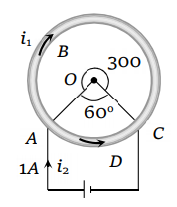
1. 0.2
2. 6
3. 1
4. 5
A coil having N turns is wound tightly in the form of a spiral with inner and outer radii a
and b respectively. When a current I passes through the coil, the magnetic field at the
centre is
1.
2.
3.
4.
A non-planar loop of conducting wire carrying a current I is placed as shown in the figure. Each of the straight sections of the loop is of length 2a. The magnetic field due to this loop at the point P(a,O,a) points in the direction

1.
2.
3.
4.
A long straight wire along the Z-axis carries a current I in the negative Z direction. The magnetic vector field at a point having coordinates (X,Y) in the z = 0 plane is
1.
2.
3.
4.
A particle of charge +q and mass m moving under the influence of a uniform electric field and a uniform magnetic field follows trajectory from P to Q as shown in figure. The velocities at P and Q are and −2 respectively. Which of the following statement(s) is not correct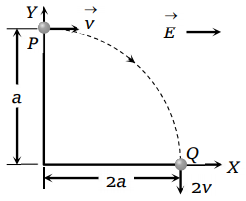
1.
2. Rate of work done by electric field at P is
3. Rate of work done by electric field at P is zero
4. Rate of work done by both the fields at is zero
For a positively charged particle moving in a x -y plane initially along the x -axis, there is a sudden change in its path due to the presence of electric and/or magnetic fields beyond P. The curved path is shown in the x−y plane and is found to be non-circular. Which one of the following combinations is possible
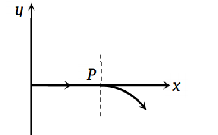
1.
2.
3.
4.
A particle of charge and mass moves in a circular orbit of radius r with angular speed . The ratio of the magnitude of its magnetic moment to that of its angular momentum depends on:
1.
2.
3.
4.
A particle of mass and charge moves with a constant velocity v along the positive x direction. It enters a region containing a uniform magnetic field B directed along the negative z direction, extending from x=a to x=b. The minimum value of v required so that the particle can just enter the region x>b is
1. qbB/m
2. q(b−a)B/m
3. qaB/m
4. q(b+a)B/2m
A thin circular wire carring a current I has a magnretic moment M. The shape of the
wire is changed to a square and it carries the same current. It will have it carries the
same current. It will have a magnetic moment
1. M
2.
3.
4.
A current carrying loop is placed in a uniform magnetic field in four different orientations, I, II, III & IV arrange them in the decreasing order of potential Energy
I. 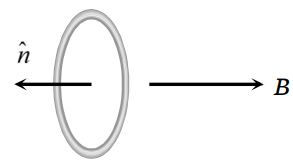
II. 
III. 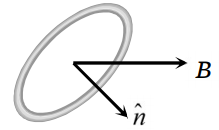
IV. 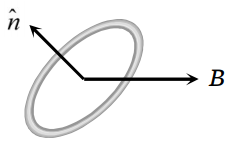
1. I > III > II > IV
2. I > II > III > IV
3. I > IV > II > III
4. III > IV > I > II
A ring of radius R, made of an insulating material carries a charge Q uniformly distributed on it. If the ring rotates about the axis passing through its centre and normal to plane of the ring with constant angular speed , then the magnitude of the magnetic moment of the ring is
1.
2.
3.
4.
A particle with charge q, moving with a momentum p, enters a uniform magnetic field normally. The magnetic field has magnitude B and is confined to a region of width d, where , the particle is deflected by an angle in crossing the field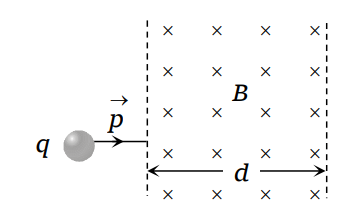
1.
2.
3.
4.
In the given figure net magnetic field at O will be 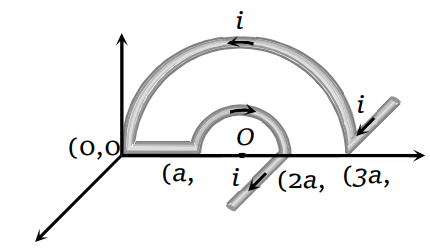
1.
2.
3.
4.
In the following figure a wire bent in the form of a regular polygon of n sides is inscribed in a circle of radius a. Net magnetic field at centre will be
1.
2.
3.
4.
PQRS is a square loop made of uniform conducting wire the current enters the loop at P and leaves at S. Then the magnetic field will be
1. Maximum at the centre of the loop
2. Zero at the centre of loop
3. Zero at all points inside the loop
4. Zero at all points outside of the loop
A proton (or charged particle) moving with velocity v is acted upon by electric field E and magnetic field B. The proton will move undeflected if
1. E is perpendicular to B
2. E is parallel to v and perpendicular to B
3. E, B and v are mutually perpendicular and
4. E and B are both parallel to v
Three long, straight parallel wires carrying current, are arranged as shown in figure. The force experienced by a 25 cm length of wire C is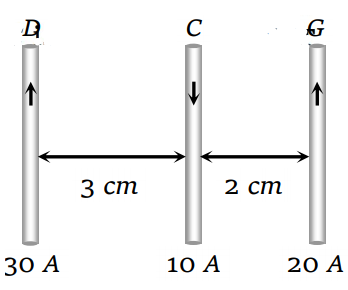
1.
2.
3. Zero
4.
Two long parallel wired are at a distance 2d apart. They carry steady equal currents flowing out of the plane of the paper, as shown. The variation of the magnetic field B along the line XX' is given by
1. 
2. 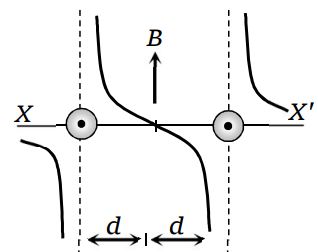
3. 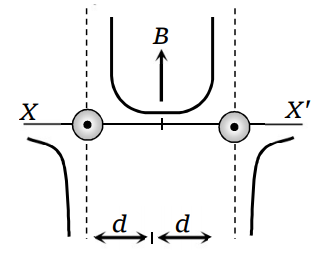
4. 
A wire carrying a current i is placed in a uniform magnetic field in the form of the curve = . The force acting on the wire is 
1.
2.
3.
4. Zero